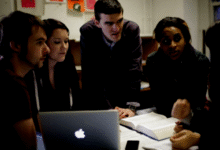The Evolution of Classroom Design: Insights from Meri Education

Classroom design has undergone a transformative journey over the years, transitioning from traditional, rigid setups to dynamic and student-centric environments that prioritize collaboration, innovation, and holistic learning experiences. At the forefront of this evolution is Meri Education, a leading institution offering invaluable insights into the intricacies of modern classroom design. By integrating research, pedagogical innovation, and technology, Meri Education underscores the importance of creating adaptable spaces that cater to diverse learning styles, foster creativity, and empower students to thrive in today’s rapidly evolving educational landscape.
Table of Contents
ToggleEvolution of Classroom Design
With a focus on student-centered approaches, tech-integrated learning spaces, and ergonomic considerations, Meri Education’s insights illuminate the multifaceted dimensions of classroom design. By emphasizing collaborative learning environments, innovative pedagogies, and inclusive practices, Meri Education champions a holistic approach that transcends traditional boundaries, paving the way for transformative educational experiences that prepare students for success in the 21st century.
Traditional Classroom Settings
Historically, classrooms were characterized by rigid rows of desks facing a chalkboard at the front. This design was rooted in the pedagogical approach of teacher-centered instruction, where knowledge flowed in one direction: from the teacher to the students. However, this layout often limited interaction among students and restricted collaborative learning opportunities.
Shift towards Collaborative Spaces
Recognizing the limitations of traditional classroom settings, educators and designers began advocating for more flexible and collaborative learning environments. Meri Education emphasizes the importance of creating spaces that facilitate group work, discussions, and interactive learning experiences. As a result, classrooms started adopting modular furniture, movable desks, and flexible seating arrangements that could be easily rearranged to accommodate different learning activities.
Read More: Top 8 Great Tools to Bring STEM Into Any Classroom.
Integration of Technology
The digital age brought about a significant transformation in classroom design, with technology playing a pivotal role. Meri Education underscores the importance of integrating technology seamlessly into the learning environment. This includes incorporating interactive whiteboards, digital projectors, and collaborative tools that enable students to engage with content in innovative ways. Moreover, classrooms are now designed to support BYOD (Bring Your Own Device) policies, allowing students to leverage their personal devices for learning.
Emphasis on Student-Centered Learning
One of the most significant shifts observed in classroom design is the transition from teacher-centered to student-centered learning environments. Meri Education advocates for designing spaces that prioritize student engagement, autonomy, and empowerment. This involves creating zones for independent study, group projects, multimedia presentations, and hands-on activities. By catering to diverse learning styles and preferences, these environments foster a more personalized and immersive learning experience.
Incorporation of Flexible Learning Zones
Meri Education emphasizes the importance of incorporating flexible learning zones within classrooms. These zones cater to various learning modalities and activities, such as quiet reading corners, multimedia stations, collaborative workspaces, and presentation areas. By creating distinct yet interconnected zones, educators can accommodate different instructional strategies and promote a more dynamic and interactive learning environment.
Historical Context and Pedagogical Shifts
In the early 20th century, the industrial model of education dominated classroom design. Rows of fixed desks and a central podium emphasized a hierarchical structure, mirroring factory settings where efficiency was paramount. However, as educational theorists like John Dewey advocated for experiential learning and student autonomy, the need for adaptable classroom spaces became evident. Meri Education’s historical analysis underscores how pedagogical shifts towards constructivism and inquiry-based learning catalyzed changes in classroom layouts, emphasizing flexibility and student engagement.
Ergonomics and Human-Centric Design
Meri Education places a strong emphasis on human-centric design principles, focusing on creating classrooms that prioritize student well-being and comfort. This involves considering factors such as ergonomic furniture, optimal lighting, acoustics, and air quality. By integrating principles of biophilic design, classrooms can incorporate natural elements, such as plants and sunlight, fostering a more conducive learning environment. Moreover, Meri Education emphasizes the importance of accessibility, ensuring that classrooms are inclusive and accommodate students with diverse needs.
Technological Integration and Digital Transformation
The digital revolution has profoundly influenced classroom design, with Meri Education at the forefront of leveraging technology to enhance learning experiences. Beyond merely incorporating devices, Meri Education emphasizes the strategic integration of technology to facilitate active learning. This includes leveraging adaptive learning platforms, virtual reality simulations, and interactive multimedia resources. Additionally, classrooms are designed to support blended learning models, seamlessly integrating online and offline instructional strategies while fostering digital literacy skills among students.
Socio-Cultural Considerations and Global Perspectives
Meri Education recognizes the importance of considering socio-cultural factors and global perspectives in classroom design. In an increasingly interconnected world, classrooms serve as microcosms of diverse cultures, languages, and experiences. Meri Education emphasizes creating inclusive learning environments that celebrate cultural diversity, promote global awareness, and foster empathy among students. This involves incorporating multicultural literature, global themes, and collaborative projects that transcend geographical boundaries, preparing students to thrive in a multicultural society.
Future Trends and Innovative Practices
Looking ahead, Meri Education anticipates several emerging trends in classroom design, informed by research, innovation, and collaboration. These include the proliferation of immersive learning environments, such as augmented reality and gamification. Additionally, Meri Education emphasizes the importance of fostering lifelong learning skills, such as critical thinking, creativity, collaboration, and communication. By designing classrooms that cultivate these competencies, educators can empower students to navigate complex challenges, adapt to rapidly changing landscapes, and contribute meaningfully to society.
Read More: Top 10 Types of Flexible Classrooms: Research Is Scarce, But Promising
Conclusion
The evolution of classroom design is a reflection of broader shifts in educational paradigms and pedagogical approaches. Meri Education’s insights highlight the importance of creating flexible, collaborative, and technology-rich environments that prioritize student engagement and learning outcomes. As educators continue to innovate and adapt to changing educational landscapes, classroom design will undoubtedly remain a crucial factor in shaping the future of learning.
FAQ’s
1. What is Meri Education’s approach to classroom design?
Meri Education emphasizes creating adaptable, student-centered, and technology-integrated learning environments. Their approach prioritizes flexibility, collaboration, and holistic student development, informed by research, innovation, and best practices in education.
2. How has classroom design evolved over time according to Meri Education?
Historically, classroom design was characterized by rigid, teacher-centered layouts. However, as educational paradigms shifted towards experiential learning, constructivism, and digital transformation, classrooms evolved to become more flexible, ergonomic, and technology-rich spaces that foster student engagement, collaboration, and creativity.
3. What role does technology play in Meri Education’s classroom design philosophy?
Meri Education believes in strategic technology integration to enhance learning experiences. This involves incorporating interactive tools, adaptive learning platforms, virtual reality simulations, and digital resources that facilitate active learning, personalized instruction, and digital literacy development among students.
4. How does Meri Education consider ergonomic and human-centric design principles in classroom design?
Meri Education prioritizes student well-being, comfort, and accessibility in classroom design. They emphasize ergonomic furniture, optimal lighting, acoustics, air quality, and inclusive spaces that accommodate students with diverse needs. Additionally, they integrate biophilic design elements to create a conducive and nurturing learning environment.
5. What socio-cultural considerations influence Meri Education’s classroom design approach?
Meri Education recognizes the importance of cultural diversity, global awareness, and inclusivity in classroom design. They emphasize creating learning environments that celebrate multiculturalism, promote empathy, and prepare students to thrive in a diverse and interconnected world through inclusive resources, collaborative projects, and global perspectives.







